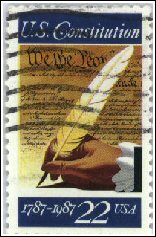
FRtR > Outlines > The American Government > The Constitution: An Enduring Document > Ratification: A new beginning
*** Index * < Previous Chapter * Next Chapter > ***
The way was now set for the arduous process of ratification, that is, acceptance by at least nine states. Delaware was the first
to act, followed swiftly by New Jersey and Georgia. Approval was
given by comfortable majorities in Pennsylvania and Connecticut.
A bitter debate was carried on in Massachusetts. That state
finally conditioned its ratification on the addition of 10
amendments guaranteeing certain fundamental rights, including
freedom of religion, speech, press and assembly; a militia
instead of a standing army; the right to trial by jury; and the
prohibition of unreasonable searches or arrests. (A number of other states added similar provisos, and the 10 amendments -- now known as the Bill of Rights -- were incorporated into
the Constitution in 1791.)

By late June 1788, Maryland, South Carolina and New Hampshire had given their assent, satisfying the requirement for ratification by nine states. Legally, the Constitution was in force. But two powerful and pivotal states -- New York and Virginia -- remained undecided, as did the two smaller states of North Carolina and Rhode Island. It was clear that without at least New York and Virginia's consent, the Constitution would stand on shaky ground.
Virginia was sharply divided, but the influence of George Washington, arguing for ratification, carried the state legislature by a narrow margin on June 26, 1788. In New York, Alexander Hamilton, James Madison and John Jay combined to produce a remarkable series of written arguments for the Constitution -- The Federalist Papers -- and won a narrow vote for approval on July 26. In November, North Carolina added its approval. Rhode Island held out until 1790, when its position as a small and weak state hedged in by a large and powerful republic became untenable.
The process of organizing the government began soon after ratification by Virginia and New York. On September 13, 1788, Congress fixed the city of New York as the seat of the new government. It set the first Wednesday in January 1789 as the day for choosing presidential electors, the first Wednesday of February for the meeting of the electors to select a president, and the first Wednesday of March for the opening session of the new Congress.
Under the Constitution, each state legislature had the power to decide how presidential electors, as well as representatives and senators, would be chosen. Some states opted for direct elections by the people, others for election by the legislature, and a few for a combination of the two. Rivalries were intense; delays in setting up the first elections under the new Constitution were inevitable. New Jersey, for example, chose direct elections, but neglected to set a time for closing the polls, which stayed open for three weeks.
The full and final implementation of the Constitution was set for March 4, 1789. But, by that time, only 13 of the 59 representatives and eight of the 22 senators had arrived in New York City. (Seats allotted to North Carolina and Rhode Island were not filled until those states ratified the Constitution.) A quorum was finally attained in the House on April 1 and in the Senate on April 6. The two houses then met jointly to count the electoral vote.
To no one's surprise, George Washington was unanimously elected the first president, and John Adams of Massachusetts, the vice president. Adams arrived in New York on April 21, and Washington on April 23. They were sworn into office on April 30, 1789. The business of setting up the new government was completed. The job of maintaining the world's first republic had just begun.
*** Index * Next Chapter > ***